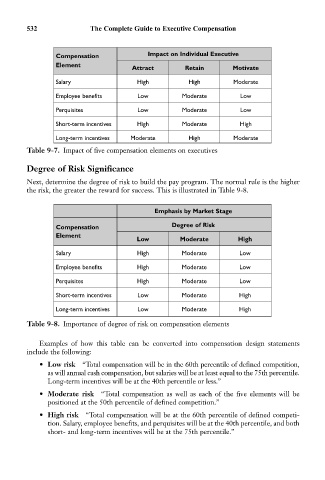Page 546 - Bruce Ellig - The Complete Guide to Executive Compensation (2007)
P. 546
532 The Complete Guide to Executive Compensation
Compensation Impact on Individual Executive
Element
Attract Retain Motivate
Salary High High Moderate
Employee benefits Low Moderate Low
Perquisites Low Moderate Low
Short-term incentives High Moderate High
Long-term incentives Moderate High Moderate
Table 9-7. Impact of five compensation elements on executives
Degree of Risk Significance
Next, determine the degree of risk to build the pay program. The normal rule is the higher
the risk, the greater the reward for success. This is illustrated in Table 9-8.
Emphasis by Market Stage
Compensation Degree of Risk
Element
Low Moderate High
Salary High Moderate Low
Employee benefits High Moderate Low
Perquisites High Moderate Low
Short-term incentives Low Moderate High
Long-term incentives Low Moderate High
Table 9-8. Importance of degree of risk on compensation elements
Examples of how this table can be converted into compensation design statements
include the following:
• Low risk “Total compensation will be in the 60th percentile of defined competition,
as will annual cash compensation, but salaries will be at least equal to the 75th percentile.
Long-term incentives will be at the 40th percentile or less.”
• Moderate risk “Total compensation as well as each of the five elements will be
positioned at the 50th percentile of defined competition.”
• High risk “Total compensation will be at the 60th percentile of defined competi-
tion. Salary, employee benefits, and perquisites will be at the 40th percentile, and both
short- and long-term incentives will be at the 75th percentile.”

